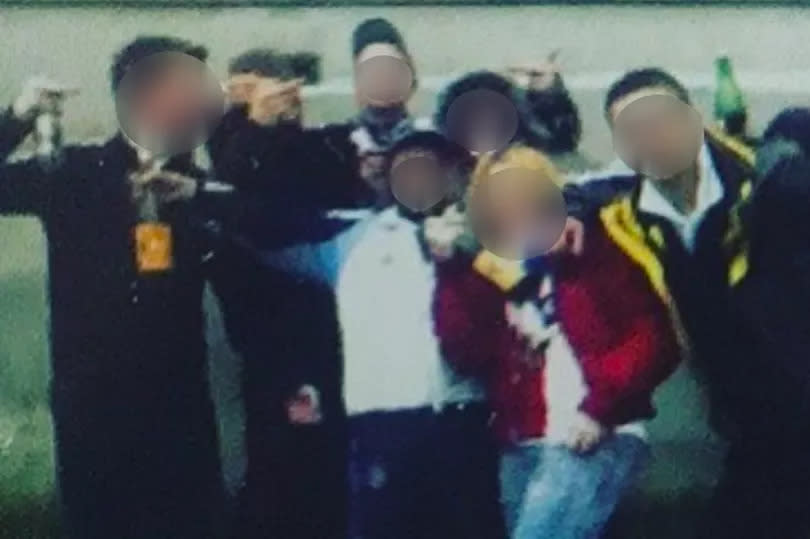How Edinburgh's 'young teams' shaped a generation of street violence in the city

In the 2000s, Edinburgh saw a surge in youth crime that hadn't been witnessed for a generation.
Youth gangs, or 'young teams' as they're known locally, have been a part of the capital's landscape for decades, but the noughties marked a significant rise in criminal activities involving teenagers and children as young as nine.
In July 2001, alarming reports surfaced about a youth crime wave sweeping through Edinburgh, while other Scottish cities like Glasgow were experiencing a five-year low.
READ MORE - Lip reader confirms Kate Middleton's regal words to George, Charlotte and Louis
READ MORE - UK set for summer heatwave with some parts set to sizzle at 30C
Data from Lothian and Borders Police showed that children were behind 47 per cent of all crimes recorded in Edinburgh. This was a stark contrast to Glasgow where only 10 per cent of crimes were committed by youngsters.
Rebellious teens from the most deprived areas of the capital were linked to a long list of serious offences ranging from vandalism, assault and robbery to housebreakings, shoplifting and car theft.
As the decade progressed, chat rooms and early social media platforms such as MySpace, MSN Messenger and Bebo seemed to significantly influence the ability of these 'young teams' in Edinburgh to organise themselves, commit crimes more efficiently and coordinate attacks on rival groups.
Suddenly, the police found themselves dealing with well-orchestrated skirmishes that often involved hundreds of youths from rival factions, many armed with an array of weapons including knives, baseball bats, bricks, wooden stakes, and metal poles.
Previously, gang clashes were mostly linked to football casuals travelling to other towns and cities for matches. But with the rise of social media, these groups from across Scotland began taunting each other online, leading to arranged confrontations.
In Edinburgh, groups like the Edinburgh Young Team and the Muirhouse Casual Fighters became infamous for their large-scale brawls, brandishing golf clubs or blades. These feuds, often sparked by online disputes, led to fights involving up to 100 young people.
Back in 2008, the Edinburgh Young Team members were not shy about their plans to engage with rival gangs such as those from Glasgow and the Young Raploch Slade from Stirling. One member brazenly stated, "We're heading to Stirling to face off against the Raploch boys. We're bringing 80 to 100 of us on the train. We'll split up between Waverley and Haymarket stations to avoid detection by the police."
The surge in youth-related crime prompted a government-funded research by the University of Edinburgh, aiming to delve into the root cause. The Edinburgh Study of Youth Transitions and Crime (ESYTC) report, published in 2010, focused specifically on Edinburgh's young teams.
It was discovered that a significant number of youngsters involved in crime were part of territorial Edinburgh gangs, with names like 'Young Niddrie Terror', the 'Young Leith Team', 'Young Pilton Derry', 'Young Mental Drylaw', 'Casual Crew', 'Young Clerrie Jungle', 'Edinburgh Young Team', Bar-Ox', 'Muirhouse Casual Firm' and the 'Young Broomhouse Team' frequently mentioned.
Many of these gangs originated in the 1960s and 1970s, when films such as A Clockwork Orange glamorised the concept of violent mob involvement for scores of Edinburgh's youth.
These gangs were found to consist of more than 20 members, primarily teenagers aged between 15 and 18 years. Some gangs even had members younger than 13.
Graffiti representing groups like the Edinburgh Young Team became a common sight in the city centre, and videos of gang fights were easily accessible online, being freely shared on social media platforms.
By the close of the 2000s, gangs had even taken to Facebook to mock the police. A notorious gang from north Edinburgh was responsible for hundreds of motorbike thefts throughout the 2010s, brazenly posting photos and videos of their joyrides on the stolen bikes.
In 2016, a study by Edinburgh University revealed that the number of street gangs in Scotland was on the decline, with youth offending also seeing a significant drop over the previous decade.
While gang-related incidents have seen a marked decrease in Edinburgh in recent years, despite the fall in serious incidents, it seems unlikely that this issue will ever be completely eradicated.

 Yahoo News
Yahoo News 
